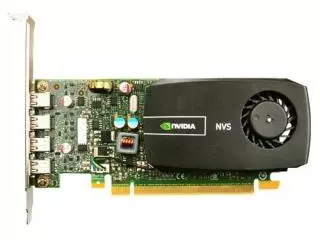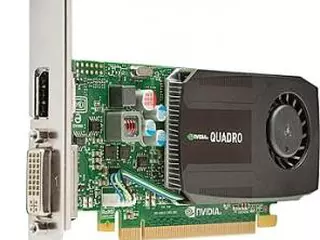NVS 510 vs Quadro K600
When choosing between NVS 510 and Quadro K600, it is worth examining the specifications of the models in detail. Do they meet the recommended requirements of modern games and software? Storage capacity, form factor, TDP, available ports, warranty and manufacturer support are all important. For example, the size of a PC case can limit the maximum thickness and length of the card. Often, instead of the factory overclocked card and RGB backlight, it is better to choose a reference model with a more efficient GPU. And make sure that your current power supply unit has the correct connection pins (using adapters is not recommended). This GPUs compare tool is meant to help you to choose the best graphics card for your build. Let's find out the difference between NVS 510 and Quadro K600.
Main Specs
NVS 510
Quadro K600
Power consumption (TDP)
35 Watt
41 Watt
Interface
PCIe 2.0 x16
PCIe 2.0 x16
Supplementary power connectors
None
None
Memory type
DDR3
DDR3
Maximum RAM amount
2 GB
1 GB
Display Connectors
4x mini-DisplayPort
1x DVI, 1x DisplayPort
Check Price
Check Price
Quadro K600 has 17% more power consumption, than NVS 510.
Both video cards are using PCIe 2.0 x16 interface connection to a motherboard.
NVS 510 has 1 GB more memory, than Quadro K600.
Both cards are used in Desktops.
NVS 510 and Quadro K600 are build with Kepler architecture.
Core clock speed of Quadro K600 is 79 MHz higher, than NVS 510.
NVS 510 and Quadro K600 are manufactured by 28 nm process technology.
Both graphics cards are the same length of 160 mm.
Memory clock speed of NVS 510 and Quadro K600 is 1782 MHz.
Game benchmarks
Assassin's Creed Odyssey
Battlefield 5
Call of Duty: Warzone
Counter-Strike: Global Offensive
Cyberpunk 2077
Dota 2
Far Cry 5
Fortnite
Forza Horizon 4
Grand Theft Auto V
Metro Exodus
Minecraft
PLAYERUNKNOWN'S BATTLEGROUNDS
Red Dead Redemption 2
The Witcher 3: Wild Hunt
World of Tanks
high / 1080p
0−1
0−1
QHD / 1440p
0−1
0−1
low / 720p
1−2
1−2
medium / 1080p
0−1
0−1
NVS 510 and Quadro K600 have the same average FPS in Assassin's Creed Odyssey.
QHD / 1440p
0−1
0−1
low / 720p
0−1
0−1
low / 768p
50−55
50−55
high / 1080p
45−50
45−50
QHD / 1440p
0−1
0−1
NVS 510 and Quadro K600 have the same average FPS in Call of Duty: Warzone.
low / 768p
60−65
60−65
medium / 768p
27−30
27−30
ultra / 1080p
7−8
7−8
high / 768p
16−18
16−18
NVS 510 and Quadro K600 have the same average FPS in Counter-Strike: Global Offensive.
low / 768p
70−75
70−75
ultra / 1080p
0−1
0−1
medium / 1080p
45−50
45−50
NVS 510 and Quadro K600 have the same average FPS in Cyberpunk 2077.
low / 768p
45−50
45−50
medium / 768p
10−11
10−11
ultra / 1080p
0−1
0−1
NVS 510 and Quadro K600 have the same average FPS in Dota 2.
low / 720p
0−1
0−1
low / 720p
21−24
21−24
medium / 1080p
0−1
0−1
NVS 510 and Quadro K600 have the same average FPS in Fortnite.
high / 1080p
0−1
0−1
QHD / 1440p
0−1
0−1
low / 720p
0−1
0−1
medium / 1080p
0−1
0−1
low / 768p
18−20
18−20
high / 1080p
0−1
0−1
QHD / 1440p
0−1
0−1
medium / 720p
12−14
12−14
NVS 510 and Quadro K600 have the same average FPS in Grand Theft Auto V.
low / 720p
0−1
0−1
low / 768p
75−80
75−80
high / 1080p
27−30
27−30
NVS 510 and Quadro K600 have the same average FPS in Minecraft.
low / 720p
8−9
8−9
NVS 510 and Quadro K600 have the same average FPS in PLAYERUNKNOWN'S BATTLEGROUNDS.
low / 720p
0−1
0−1
low / 768p
0−1
0−1
low / 768p
45−50
45−50
medium / 768p
14−16
14−16
ultra / 1080p
0−1
0−1
high / 768p
12−14
12−14
NVS 510 and Quadro K600 have the same average FPS in World of Tanks.
Full Specs
NVS 510
Quadro K600
Architecture
Kepler
Kepler
Code name
GK107
GK107
Type
Workstation
Workstation
Release date
23 October 2012
1 March 2013
Pipelines
192
192
Core clock speed
797 MHz
876 MHz
Transistor count
1,270 million
1,270 million
Manufacturing process technology
28 nm
28 nm
Texture fill rate
12.75
14.02
Floating-point performance
306.0 gflops
336.4 gflops
Length
160 mm
160 mm
Memory bus width
128 Bit
128 Bit
Memory clock speed
1782 MHz
1782 MHz
Memory bandwidth
28.51 GB/s
28.51 GB/s
DirectX
12 (11_0)
12 (11_0)
Shader Model
5.1
5.1
OpenGL
4.6
4.6
OpenCL
1.2
1.2
Vulkan
1.1.126
1.1.126
CUDA
3.0
3.0
Bitcoin / BTC (SHA256)
17 Mh/s
11 Mh/s
Check Price
Check Price

